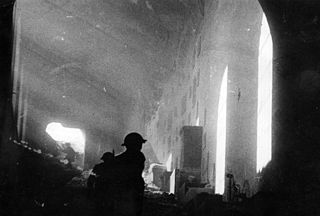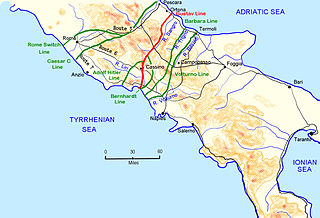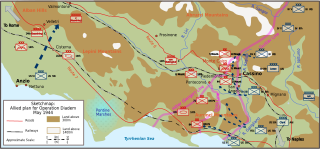
The Battle of Monte Cassino, also known as the Battle for Rome, was a series of four military assaults by the Allies against German forces in Italy during the Italian Campaign of World War II. The objective was to break through the Winter Line and facilitate an advance towards Rome.

The Battle of Anzio was a battle of the Italian Campaign of World War II that commenced January 22, 1944. The battle began with the Allied amphibious landing known as Operation Shingle, and ended on June 4, 1944, with the liberation of Rome. The operation was opposed by German and by Italian Repubblica Sociale Italiana (RSI) forces in the area of Anzio and Nettuno.

The Bernhardt Line, or Reinhard Line, was a German Army defensive line in Italy during the Italian Campaign of World War II. Having reached the Bernhardt Line at the start of December 1943, it took until mid-January 1944 for the US Fifth Army to fight its way to the next line of defences, the Gustav Line. The Bernhardt Line was defended by XIV Panzer Corps, part of the German Tenth Army.

The Winter Line was a series of German and Italian military fortifications in Italy, constructed during World War II by Organisation Todt and commanded by Albert Kesselring. The series of three lines was designed to defend a western section of Italy, focused around the town of Monte Cassino, through which ran the important Highway 6 which led uninterrupted to Rome. The primary Gustav Line ran across Italy from just north of where the Garigliano River flows into the Tyrrhenian Sea in the west, through the Apennine Mountains to the mouth of the Sangro River on the Adriatic coast in the east. The two subsidiary lines, the Bernhardt Line and the Hitler Line, ran much shorter distances from the Tyrrehnian Sea to just northeast of Cassino where they would merge into the Gustav Line. Relative to the Gustav Line, the Hitler Line stood to the northwest and the Bernhardt Line to the southeast of the primary defenses.

The 1st Special Service Force was an elite joint American–Canadian commando unit in World War II, formed by Lieutenant Colonel Robert T. Frederick of the Operations Division of the U.S. General Staff. During the Italian campaign of World War II, it was commanded by Frederick and attached to the United States Fifth Army. In August 1944, the Force was attached to 1st Airborne Task Force for the campaign in southern France.

The 2nd New Zealand Division, initially the New Zealand Division, was an infantry division of the New Zealand Military Forces during the Second World War. The division was commanded for most of its existence by Lieutenant-General Bernard C. Freyberg. It fought in Greece, Crete, the Western Desert and Italy. In the Western Desert Campaign, the division played a prominent role in the defeat of German and Italian forces in the Second Battle of El Alamein and the British Eighth Army's advance to Tunisia.

The Italian campaign of World War II, also called the Liberation of Italy following the German occupation in September 1943, consisted of Allied and Axis operations in and around Italy, from 1943 to 1945. The joint Allied Forces Headquarters (AFHQ) was operationally responsible for all Allied land forces in the Mediterranean theatre and it planned and led the invasion of Sicily in July 1943, followed in September by the invasion of the Italian mainland and the campaign in Italy until the surrender of the Axis forces in Italy in May 1945.

The VI Corps was activated as VI Army Corps in August 1918 at Neufchâteau, France, serving in the Lorraine Campaign. Constituted in the Organized Reserves in 1921, it was allotted to the Regular Army in 1933 and activated on 1 August 1940 at Fort Sheridan, Illinois. VI Corps took part in some of the most high-profile operations in World War II.

The 6th South African Armoured Division was the second armoured division of the South African Army and was formed during World War II. Established in early 1943, it was based on a nucleus of men from the former 1st South African Infantry Division who had returned to South Africa after the Second Battle of El Alamein in late 1942. The division was initially transferred to Egypt for training, after which it served in the Allied campaign in Italy during 1944 and 1945. In Italy, the division was initially deployed as part of the British Eighth Army, under command of Lieutenant-General Oliver Leese, and was then transferred to the U.S. Fifth Army, under Lieutenant General Mark W. Clark, for the remainder of the Italian Campaign. The division operated as a strongly reinforced division and was frequently used to spearhead the advance of the Corps and Army to which it was attached. They returned home after the end of the war in Italy and were disbanded in 1946. The division was also briefly active after the war from 1 July 1948 to 1 November 1949.

Operation Diadem, also referred to as the Fourth Battle of Monte Cassino or, in Canada, the Battle of the Liri Valley, was an offensive operation undertaken by the Allies of World War II in May 1944, as part of the Italian Campaign of World War II. Diadem was supported by air attacks called Operation Strangle. The opposing force was the German 10th Army.

Sir John Anthony Holt Saunders, CBE, DSO, MC was chairman of The Hongkong and Shanghai Banking Corporation, at a time of rapid and turbulent development of the Hong Kong economy. In his banking career, as chief manager from 1962, and chairman from 1964 to 1972, Saunders was at the helm of Hong Kong's most important financial institution at a time when the Crown Colony was rapidly changing from a trading post to a regional centre of manufacturing and finance.

The 44th Infantry Division was formed on 1 April 1938 in Vienna, about two weeks after the Anschluss of Austria. It first saw combat at the start of the war in the Invasion of Poland, and also took part in the Battle of France in 1940. After a 9-month period of coastal defence the division was transferred East. On 22 June 1941, the division took part in the invasion of the Soviet Union, attached to Army Group South. It remained in the east after the failure of "Operation Barbarossa", taking part in defensive actions for the winter against the Soviet Army offensives near Izum and Kharkov. Refurbished, the division participated in the German summer offensive, and was subsequently destroyed with the 6th Army at Stalingrad in January 1943.

X Corps was a corps of the British Army that served in the First World War on the Western Front before being disbanded in 1919. The corps was re-formed in 1942 during the Second World War and saw service in the North African Campaign and the Italian Campaign where it came under command of the US Fifth Army and the British Eighth Army.

The Battle of San Pietro Infine was a major engagement from 8–17 December 1943, in the Italian Campaign of World War II involving Allied forces attacking from the south against heavily fortified positions of the German "Winter Line" in and around the town of San Pietro Infine, just south of Monte Cassino about halfway between Naples and Rome.

The French Expeditionary Corps (FEC) (French: Corps Expéditionnaire Français, CEF), also known as the French Expeditionary Corps in Italy (FECI) (French: Corps Expéditionaire Français en Italie, CEFI), was an expeditionary force of the French Liberation Army. Created in 1943, the corps fought in the Italian Campaign of World War II, under the command of General Alphonse Juin. Consisting of 112,000 men divided into four divisions, all but one of the divisions were colonial units, mostly Moroccans and Algerians drawn from the Army of Africa and led by French officers. Overall approximately 60% of the Expeditionary Corps was composed of colonial troops.

13th Corps was a corps-sized formation of the British Army that fought on the Western Front during the First World War and was reformed for service during the Second World War, serving in the Mediterranean and Middle East throughout its service.

I Canadian Corps was one of the two corps fielded by the Canadian Army during the Second World War.

Major General Fred Livingood Walker was a highly decorated senior United States Army officer who served in both World War I and World War II and was awarded with the second highest military decorations in both wars, the Distinguished Service Cross (DSC). During World War I he commanded a battalion on the Western Front, fighting with distinction in the Second Battle of the Marne in July 1918. During World War II, Walker commanded the 36th (Texas) Infantry Division throughout its service in the Italian campaign, from September 1943 until June 1944.

15th Panzergrenadier Division was a mobile division of the German Army in World War II.

The Battle of Rapido River was fought from 20 to 22 January 1944 during one of the Allies' many attempts to breach the Winter Line during the Italian Campaign of World War II. Despite its name, the battle occurred on the Gari River.



















